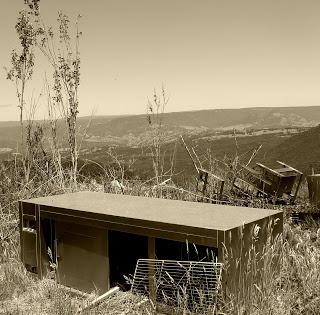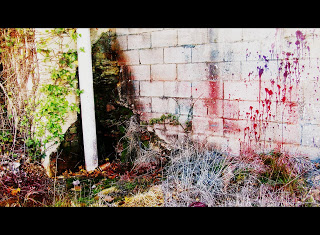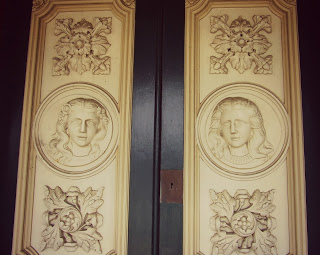Continued from the Patchwork Hospital, last month- sorry it took such a long time for Part Two. I got… distracted.
There’s a hotel, just past Katoomba- it may be at Medlow Bath, or one of those other tiny villages that you only just see as you cruise past them, driving music pumping, on the highway toward Lithgow. It is all those things that appeal to me about the Blue Mountains of NSW, epitomised and structured and– currently– being refurbished. It’s a glorious, majestic, glamour of a building, the main structure stacked on top of– well, built into, actually– the side of the mountain.

It may have been opened in 1901, the premiere luxury hotel for economically well–off Mountain travelers. Perhaps- just perhaps- it was originally opened as a ’hydrotherapy centre’, it’s siren song fueled by the rumour of underground springs- a flowing, crystal clear sub-terrain stream of mystical spring water. Some kind of life elixir that promised health and healing, a balm to the strains of upper-class existence. Unfortunately, by the time the this establishment, with all it’s flourishes, lead-lit glass and sculptured carpentry was actually opened, the river od mystical waters had dried up. Whether it ever actually existed is a historical anomaly- no one knows for sure.
Not that it mattered. People still flocked to the decadent hotel, dressed in their finest, to partake in the opulent accommodation, be seen in the even more opulent casino room. To honeymoon and bushwalk, canyon and relax.
This hotel may been closed for refurbishments for as long as I can rememeber. It’s one of those things, like the random concrete sculpture, that I like to drive past with unassuming people who don’t know it’s there. Because they almost never fail to say something long the lines of ’What the f*ck was that??!’
I’ve wanted to explore here since the first time I did that myself.
There doesn’t seem to be much to see, many places to go, when you first pull up directly in front of the chain link fence with it’s huge gates that surround three quarters of the property. The far side, the back entrance, ti doesn’t need a fence- the buildings sits only five metres from a cliff face, a gradient so steep it’s almost vertical, covered with the barbed wire of the bush- a dozen different hard-limbed trees and plants, thick scrub to impede movement and break ankles. The hotel (maybe- all this is in theory, of course) directly on the main road, and Dear Brad and I aren’t the only tourists and explorers who have stopped here today for a sticky beak. An older couple are wandering the forecourt of the building, well inside the security fencing; and there’s another car parked here, too, who’s occupants are yet to show themselves. There’s someone else actually parked inside the grounds, again within the fence, one of the makeshift gates slightly ajar. There’s four of five large buildings that make up the property, most of them branching to the left of the original hotel and casino. Only one tall rooming house has been built to the right of the original, and it’s one stark white, ugly against the softness of the original cream, desolate against the perfectly clear skyline behind it. The Person With Keys, the one parked inside, is throwing random, indiscernible junk from the front door of the white building into a shiny silver skip-bin sitting angled near the building’s steps.
This feels stupid, unnecessarily risky, and I’m breaking rules… I’m almost positive that this particular place can not really be classified as ’abandoned’. Caution versus Bravery, and Bravery whispers that if I don’t do this now it may just be years before I come back here again. And by that time this endless construction work– which actually doesn’t seem to have begun– will be over and I’ll have to pay a few hundred dollars for the privelege of checking all this out.
“Come on, then,” I say to Dear Brad, who seems as hesitant as I am, and I sling my camera bag round my neck and walk through the front gate, trying to swagger along as though I have every right in the world to be here.
 |
| The view over the Blue Mountains. |
We pass the older couple, who smile and say good morning, and we reply in turn. There’s a certain surreality in feeling as though you’re taking a casual morning stroll through the windswept grounds of a neglected hotel, the moulded Taj Mahal roof of the casino as a backdrop.
Like the PatchWork Hospital, the gardens here were once gorgeous. While not yet quite as rampant as the hospital grounds, given another few years they certainly could be. Leaves and weeds form heaps around roses that are aaphid infested and badly need a prune. The rudiments of catering white goods– coffee pots and industrial toasters, along with random chairs and tables- are stacked against the ochre-colored walls of the hotel wing that skirts the side of the courtyard. There’s a pool, a dolphin dry docked and suspended mid leap, the only water against the deep blue of the pool’s sides a few inches of murky green curdled algae-sludge layering the pool floor.
Between the casino on one side and the pool on the other there is a rotunda, a circular driveway to pull into while you register your stay or return your room keys. Despite the huge pillars, it takes a moment to realize that’s what it is, exactly– creeping weeds and disheveled gravel have blurred the boundaries and lines of the through-way.
This is the drive past facade, the public front of the majestic, antiqued hotel. Combined with the casino, with it’s dramatic domed roof and carved wood and stained glass doors, set high in contrast against the skyline as the valley falls away behind it; it’s all stark and gothic and fraught and brings a sense of tough but somehow sheltered people, dressed in all their finery but living here, in the unforgiving Australian bushland, with the somewhat desolate, bone–chilling cold of mountain winters. Silly feathers and fuss, the almost willful, blind ignorance that comes with having enough money to close your door on the hard parts of life; contrasted with the rugged savagery of actua
lly surviving in this environment a hundred years ago.

The public front of the building is too easy. The chain link fence sections off these main buildings– connected, it seems, so guests did not get wet feet or freeze the tips of their noses while traveling between dining room and bedroom, bedroom and casino– from the next squat structure to the left, which is old and white and looks like an oversized shoebox with tiny squares cut down the length of it’s side for peeking porthole windows. Dear Brad and I turn and walk back the way we came, aiming for the gate again in order to walk the perimeter that bit further and find a way over to the next stretch of security fencing.
“Fire truck.” says Dear Brad. He’s stopped just inside the gate and looks thoroughly confused.
“What?”
“Fire truck!!”
And that’s just what he means… fire truck. As in, a real, read and shiny full-sized tanker parked right here, behind my car, lights flashing and firemen– paid fireman, not volunteer– in big black shiny jackets climbing up and down into the cab and looking as though they are actually preparing to leave again. One of them sees me looking his way and smiles and waves, and I wave back, again with that surreality– I’m standing directly behind the ‘No Trespassers!!’ sign and nobody is even the slightest bit fussed. Person With Keys is still dumping random things in the skip bin, seemingly also nonplussed by flashing emergency lights, nor trespassers with cameras.
 |
| Back of the hotel, looking north. |
The firies drive off, and one waves to me again, fingers flicking a small salute off his helmet as they pull out on the highway.
Dear Brad and I look at each other, and I’m imagining that, by now, I appear just as confused as he is.
“What the…?”
“I have no idea. But they obviously didn’t mind us being here, so lets go…” (Yes, I said that a lot to Dear Brad this weekend. Anyone who comes exploring with me hears “Come onnnnnn, let’s go!!” on a semi-regular basis.) I don’t care how chilled the local fire brigade are about harmless but still illegal trespassing… The local cops may not feel the same way. And my theory always is- get in, get out. Loitering attracts more attention than stealth movement.
And there’s so much more here to see.
Further down the fence line– the entire property runs for a good five hundred metres along the main highway, and sits directly opposite a tiny sandstone train station– the chain link stops and only the original fencing remains. It’s short and squat, all five foot high concrete pillars connected by concrete spans at the bottom and top. Again, too easy– one leg over, then the other, choose a branch from one the olive trees just inside the fenceline with which to steady yourself, the drop the six foot or so onto the other side,where the ground is slightly lower.

There’s a mismatched group of three or four outbuilding on this side of the fence, most of them still connected to the main hotel buildings with long, tacked on corridors. This is obviously the lower socio-economic end of the Hydro Majestic, and it seems the small white shoebox building we toward first was either the (very) public accommodation for coachmen and traveling servantry, or the staff quarters. It’s dark and dingy and the rooms closest to the road have the feel of dampness, of places so shaded by thick tress that they get very little sunlight at all. And, of course, without the heavy fencing and their imposing security signs making a veritable fortress of this side of the hotel, this building has become an easy target for vandals. It’s not so much graffiti, not even evidence of squatters leaving behind piles of chip packets and soft drink bottles or impromptu fireplaces. The evidence points toward simple, wanton teenaged destruction– things broken, moved and dismantled; order made into mess simply because it’s here and unprotected and they’ve never had so much freedom and power over any environment before in their lives.
In the far back corner of the shoebox building is a kitchen, stripped of anything useful. Every other room, opening methodically off the dark central hallway, is a tiny sleeping space with an identically sized tiny window. The contents of each room differs– some are filled with furniture, some have nothing at all. The roof has come down in some places, throwing merciful thick fingers of slanty sunlight to dry the dampness caught in carpet and upholstery.
The first two rooms are strewn with papers. Cardboard filing boxes are stacked atop one another, drunkenly squashing each others corners and creating compressed heaps of paper. The boxes not stacked up are strewn like snow drifts, piles of looseleaf printed A4′s acting as a slippery, shifting sandhill carpet. I pick up a few of them, shake my head, let them float back toward the floor.
“What are they?” asks Dear Brad.
“Receipts. And invoices and envelopes and stationery and brochures. I’m guessing when the new owners come looking for all the past paperwork from the hotel… this is where they’ll find it.” And again, I wonder… how the hell did it all get here? Who’s job was it, to file and store documentation? What point did they decide ‘Oh fuck it, I’ll just stack all the paperwork here in an unlocked moldy old boarding house?’
Behind the shoebox is another, slighter smaller white Fibro building, fewer windows, more doors. It was, apparently, the care-takers shed on one side, his equipment shed and maintenance room on the other. The tools are, of course, gone, but most of the fittings and random accessories are still here. There’s a calendar on the wall, stopped at March 2007. Screwed to the door of what I’m assuming was, once, the caretakers office– a desk, chair, even a stained and crazed coffee cup still sit dustily inside the small nook– is a sign, obviously salvaged by maintenance when there still was maintenance here. It reads ’Shipley Room’, lettered gold on dark olive paint. It’s from within the hotel proper, and I find myself bre
aking the rules again… coveting. I source a butter knife from the floor, carefully untwist the screws from the thick wood. And take it home for the fairy garden. Righteous bubble broken, I gather intermittently as we pick our way back toward the exit- a red ’fire phone’ with only the handset and cradle, no buttons, lays in a heap of plastic bags and crockery on the floor; so I salvage that, too, and nail it to a pole in the garden for my kids to play with.
 |
| Inside the staff quarters. |
The guilt is only slight. Skip bins… they nullify the notion of stealing, somewhat.
The last outbuilding appears to be the oldest, older even than the hotel itself, ad the romantic in me imagines a pumping station for the ghost of underground springs. Two squat stories of hand-pressed brick, it’s last incarnation seems to have been as an engine room, boiler room and storage shed. The bottom floor is boring, greasy and mechanical. On the far side of the external walls there’s a rusted metal flight of stairs leading to a landing that looks rotted with concrete cancer. I start up them and on the fourth step the entire staircase swings lazily with my weight.
“I’m not sure it’s safe…” I call out to Dear Brad.
“I don’t think so, either.” He replies, and twenty seconds later he’s past me, up on the second floor anyway, laughing and telling me to get a move on, if it held his weight it will hold mine.
 |
| The bathroom in the sky |
He was lucky it was worth it. Upstairs was another living quarters, same dusty rooms with worn out furniture stored here that has long been forgetten, or that has no place else to go. But, strangely, what was left of the tiny bathroom was… amazing. A small shower next to a large window that looked out over the valley behind the hotel. Hectares of sweeping greenery, too high and close to view the steep drop off of the cliff so you appeared to be standing on the very top of the world. It’s the coolest bathroom I’ve ever seen In Real Life and again there’s that tugging, pensive sadness. The feeling of things being left to fall part, to rot in the absence of every day interaction with humanity.
Miraculously, the rickety stairs don’t collapse on the way back down. We head toward the back of the hotel, toward another outdoor stairwell, this one a huge set of stark silver fire stairs that are attached to the side of the main bulpilding– a legality necessity that is also an ugly modern eyesore. But the view from the top is breath taking, too huge to take in all at once, so gloriously lush that it catches your breath deep in your chest. It doesn’t take long before vertigo chases me down, down, down until I’m just one flight from the top, a comfortable threshold where I can be sure I’m placing my feet on something solid, where I’m no longer dizzy and my body trusts itself to stay vertical and not slide itself awkwardly through a gap too small for me to fit through anyway and send me plummeting toward the emerald green ground below.
 |
| The hotel, built into the rock |
“Hey… can you see that?” asks Dear Brad softly once he’s caught up again at the foot of the fire stairs, “that door, at the back there… it’s open.”
And damned if he wasn’t right- there was a door, at the very back of the hotel, right against where the cliff drops away. And it was standing open, unlocked, exposing an almost empty room with a huge mirror mounted on the far wall. Seemingly out of place and jarred with the old–fashioned decor, the only objects with the room were two or three huge gym–sized treadmills, a dainty coating of dust and the beginnings and trendilling ends of silky spiderwebs ornating the curving handles and blanketing the running belts.
Continued tomorrow… (really tomorrow, this time. Promise.)









































